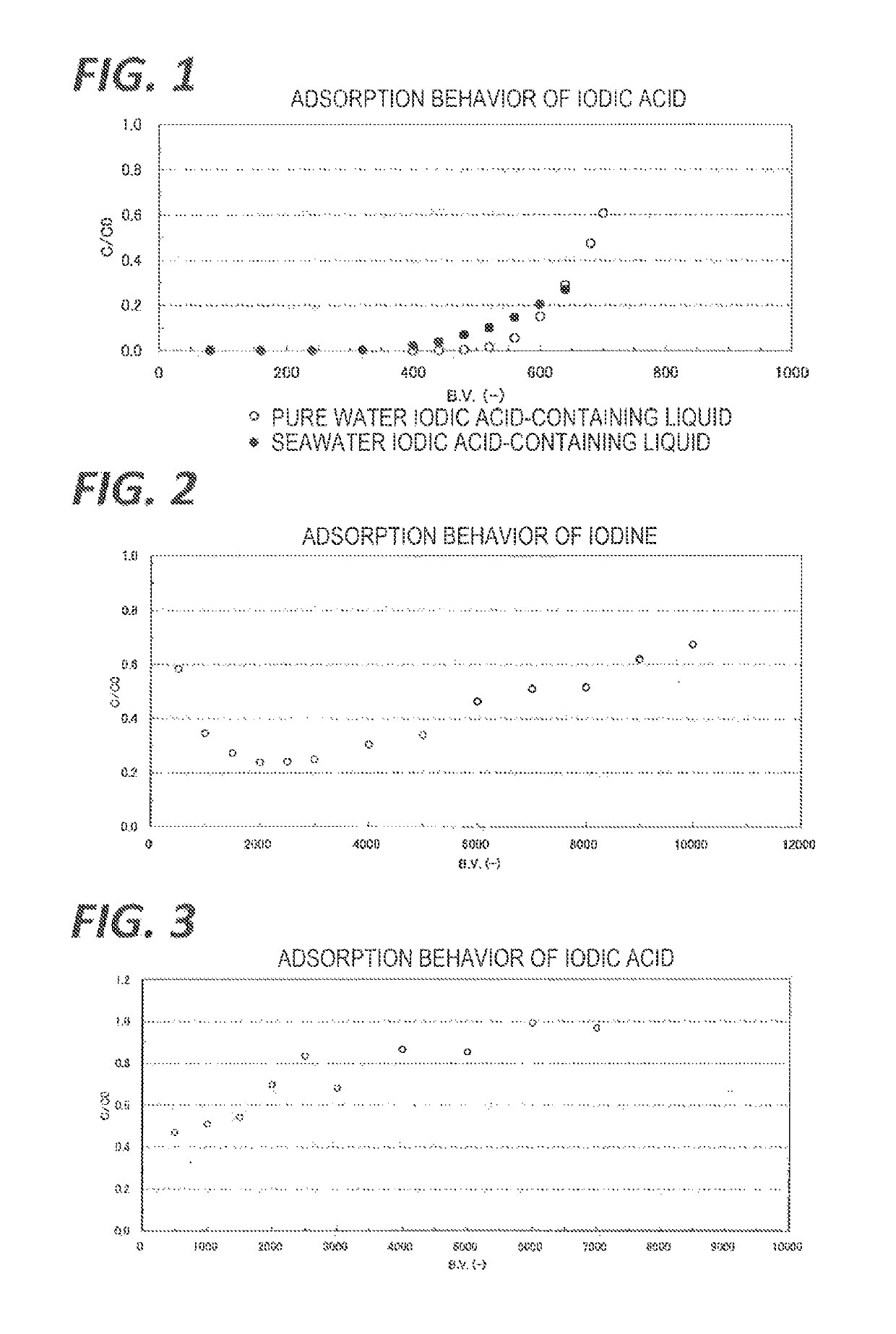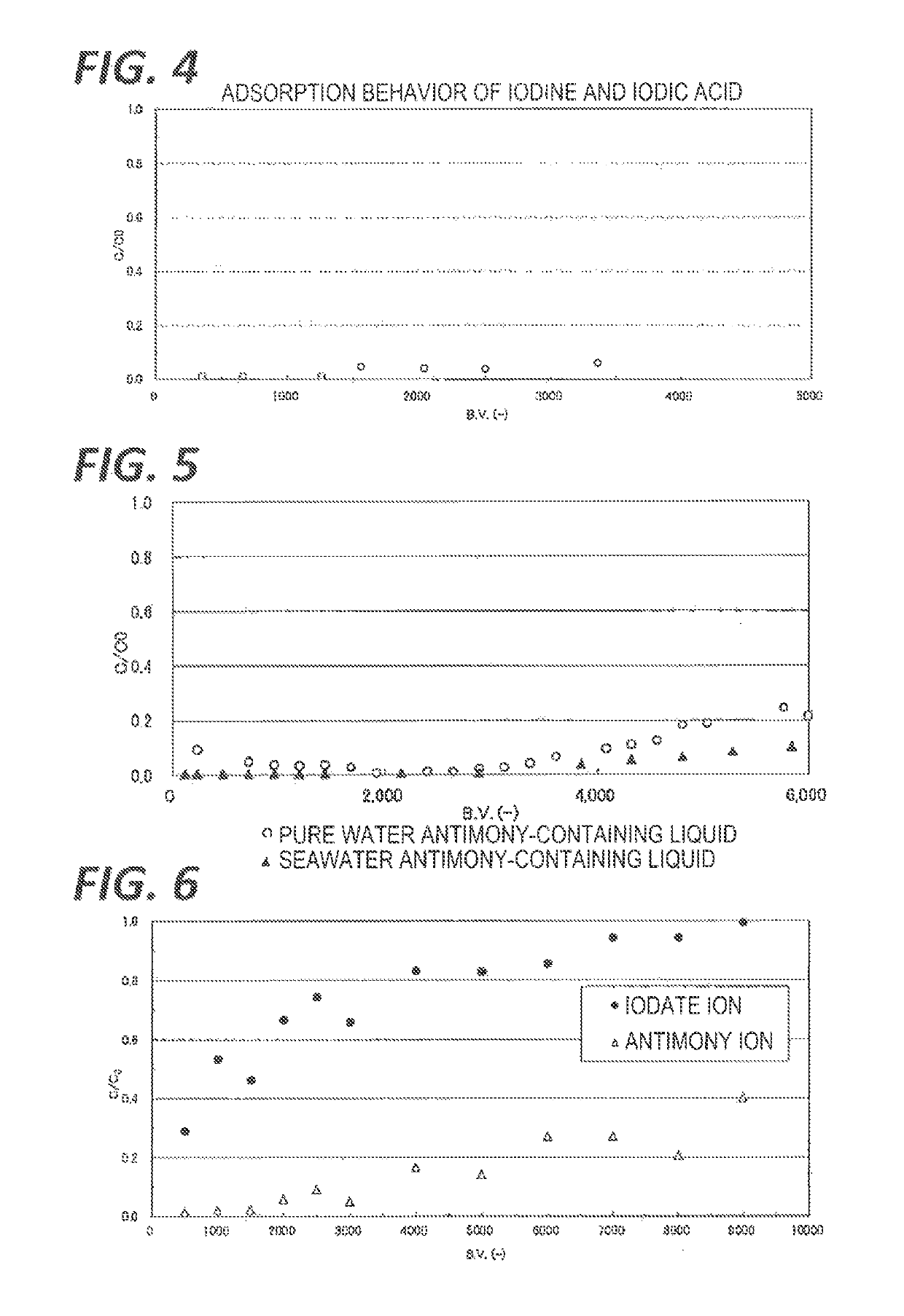Adsorbent for adsorbing iodine compounds and/or antimony, method for preparing said adsorbent, and method and apparatus for treating radioactive waste liquid by using said absorbent
a technology of antimony and iodine compounds, which is applied in the field of new adsorbents, methods for preparing novel adsorbents, and methods for treating radioactive waste liquids by using adsorbents, which can solve the problems of internal radiation exposure, radioactive materials produced, and iodine collection in the thyroid gland, and achieve excellent adsorption performance of antimony ions and economic feasibility
- Summary
- Abstract
- Description
- Claims
- Application Information
AI Technical Summary
Benefits of technology
Problems solved by technology
Method used
Image
Examples
preparation example 1
Preparation of Adsorbent Used in Example 1
[0056]The moisture content of commercially available cerium hydroxide particles was adjusted to 14 to 16 parts by weight based on 100 parts by weight of a rare earth element hydroxide (dry product). Subsequently, a polymer resin solution was prepared by dissolving a polymer resin in an organic solvent, and a dispersion was obtained by dispersing 600 parts by weight of hydrous hydroxide particles of the rare earth element based on 100 parts by weight of the polymer resin. The obtained dispersion was molded into an aggregate having a secondary particle average particle diameter of 0.2 mm to 5.0 mm by means of a melt granulation method. After the molding, the aggregate was washed sufficiently, and water and the adsorbent were separated by means of a sieve, thereby classifying Adsorbent 1 having a particle diameter of 0.35 to 1.18 mm.
preparation example 2
Preparation of Adsorbent Used in Examples 2 and 3
[0057]The moisture content of commercially available cerium hydroxide particles was adjusted to 14 to 16 parts by weight based on 100 parts by weight of a rare earth element hydroxide (dry product). Subsequently, a polymer resin solution was prepared by dissolving a polymer resin in an organic solvent, and a dispersion was obtained by dispersing 425 parts by weight of hydrous hydroxide particles of the rare earth element based on 100 parts by weight of the polymer resin and 50 parts by weight of silver zeolite particles based on 100 parts by weight of the polymer resin. The obtained dispersion was molded into an aggregate having a secondary particle average particle diameter of 0.2 mm to 5.0 mm by means of a melt granulation method. After the molding, the aggregate was washed sufficiently, and water and the adsorbent were separated by means of a sieve, thereby classifying Adsorbent 2 having a particle diameter of 0.35 to 1.18 mm.
preparation example 3
Preparation of Adsorbent Used in Example 4
[0058]The moisture content of commercially available cerium hydroxide particles was adjusted to 14 to 16 parts by weight based on 100 parts by weight of a rare earth element hydroxide (dry product). Subsequently, a polymer resin solution was prepared by dissolving a polymer resin in an organic solvent, and a dispersion was obtained by dispersing 390 parts by weight of hydrous hydroxide particles of the rare earth element based on 100 parts by weight of the polymer resin and 40 parts by weight of silver zeolite particles based on 100 parts by weight of the polymer resin. The obtained dispersion was molded into an aggregate having a secondary particle average particle diameter of 0.2 mm to 5.0 mm by means of a melt granulation method. After the molding, the aggregate was washed sufficiently, and water and the adsorbent were separated by means of a sieve, thereby classifying Adsorbent 3 having a particle diameter of 0.35 to 1.18 mm.
PUM
| Property | Measurement | Unit |
|---|---|---|
| particle diameter | aaaaa | aaaaa |
| particle diameter | aaaaa | aaaaa |
| particle diameter | aaaaa | aaaaa |
Abstract
Description
Claims
Application Information
 Login to View More
Login to View More - R&D
- Intellectual Property
- Life Sciences
- Materials
- Tech Scout
- Unparalleled Data Quality
- Higher Quality Content
- 60% Fewer Hallucinations
Browse by: Latest US Patents, China's latest patents, Technical Efficacy Thesaurus, Application Domain, Technology Topic, Popular Technical Reports.
© 2025 PatSnap. All rights reserved.Legal|Privacy policy|Modern Slavery Act Transparency Statement|Sitemap|About US| Contact US: help@patsnap.com


